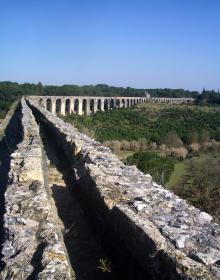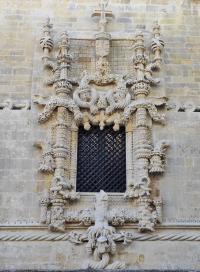- HOME
- MONUMENT
- Convent of Christ
- History
- Architecture
- Personalities
- King Afonso Henriques
- D. Gualdim Pais
- King Dinis
- King John I
- D. Lopo Dias de Sousa
- King Duarte
- Prince D. Henrique (Henry
- King John II (1455 - 1495
- King Manuel I (1469 - 152
- Diogo de Arruda
- João de Castilho
- Jorge Afonso
- Olivier de Gand
- King John III (1502 - 155
- Diogo de Torralva
- Friar Anthony of Lisbon
- Baltazar de Faria
- Filipe Terzi
- Philippine Dinasty
- King Philip II of Spain
- King John IV
- Domingos Serrão
- Queen Mary II
- Prince Fernando
- Costa Cabral
- Artisans and Artists
- Intangible Heritage
- Related Heritage
- Glossary
- VISIT OUR MONUMENT
- HERITAGE LEARNING
- TOMAR
- MONASTERIES ROUTE

The Monumental Complex
The monumental complex that is the Convent of the Order of Christ began with the construction the Castle of the Knights Templar in 1160. Work on the Templars' Oratory or Charola commenced at the same time. These works were completed at the end of the 12th century. The site in Tomar was to remain the seat of the Knights Templar in Portugal for some 130 years.The closure of the Order of the Knights Templar in 1312 led to the establishment in Portugal, under King Dinis, of the Order of Christ (in 1319).
The Order of Christ, which inherited the assets, favours and privileges of the Templars, marked the beginning one of the golden periods of Portuguese history, the Age of the Discoveries, which led to the opening of Portugal to the world.
The Infante Henrique, who was to become known as Henry the Navigator, had a palace built on part of the Templars' military headquarters in 1420. He also extended the monastic premises, adding two new cloisters (the "Washing" and "Cemetery" cloisters). This Prince of the Royal House of Avis, who was also Master of the Order of Christ, planned his overseas expansion strategy here on the basis of the knowledge and technologies inherited from the Knights Templar.
Using the riches from overseas that started arriving in Portugal from the beginning of the 16th century onwards, King Manuel I, who also became Master of the Order of Christ, commissioned the remodelling of the complex at Tomar, leading to a decorative discourse that celebrates the mysticism of the Order of Christ and the Portuguese Crown in a grandiose representation of power and faith.
João II ordered the reformation of the Order, with the introduction of clausura, and further extended the Convent so that it could house the community of monks. These works transformed the Convent into a sumptuous work of architecture that was later completed by the magnificent aqueduct commissioned by Philip II of Spain.
This group of diverse spaces, which were built over several centuries, have made the Convent of the Order of Christ a grandiose monumental complex which merited recognition by UNESCO and inscription in the list of World Heritage Sites in 1983.
SERVICES - ACTIVITIES




